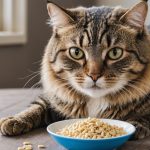Understanding Cataracts in Senior Cats
Cataracts in senior cats significantly impact their vision and quality of life. Cataracts are characterised by a clouding of the eye’s lens, which impedes light reaching the retina, leading to blurry vision. They typically develop gradually over time, beginning as small, cloudy spots on the lens that grow larger as the condition progresses. This cloudy appearance results from changes in water and protein within the lens.
In senior cats, the development of cataracts can be influenced by various factors, including age-related degeneration, genetic predisposition, or underlying health issues like diabetes. Detection in the early stages is crucial as it allows for a better management plan, potentially preventing further deterioration of eyesight.
Also to discover : Selecting the perfect probiotic formula and dosage to boost your cat”s digestive wellness
Understanding and spotting early signs of cataracts is vital. Noticing subtle changes, such as increased clumsiness or hesitation in unfamiliar surroundings, might indicate vision impairment. If left undetected, cataracts can lead to blindness, significantly affecting the cat’s ability to explore and interact with its environment. Owners should prioritise routine vet visits to monitor eye health. Early detection can make a substantial difference in maintaining a senior cat’s quality of life by addressing the condition promptly.
Signs of Early Cataracts in Cats
Recognising the early signs of cataracts in cats is crucial for maintaining their well-being. Common symptoms to be attentive to include a noticeable cloudiness in the cat’s eyes, which may manifest as an opaque or greyish appearance. This is often accompanied by vision impairment, leading to more pronounced behavioural changes. Cats might display increased clumsiness, avoid jumping, or appear hesitant in navigating familiar spaces. By identifying these early indicators, pet owners can seek timely intervention and management.
Changes in behaviour are significant indicators of vision problems. You may notice your cat becoming confused or disoriented, especially in dimly lit areas. Observing these behavioural modifications is essential, as they are often subtle yet reliable indicators of deteriorating eyesight.
Regular observation and heightened awareness play key roles in identifying cataracts early. It’s important to regularly monitor your cat’s habits and look for any deviations from their normal behaviour. Conduct routine checks of the eyes for any visible alterations. Early detection of cataracts can improve treatment outcomes, thereby preserving your cat’s quality of life. Promoting awareness and taking proactive measures can prevent the progression of vision impairments, ensuring that your cat remains comfortable and active.
Methods for Detecting Cataracts
Detecting cataracts in senior cats involves a combination of veterinary assessments and at-home observations. Recognising changes in your cat’s eye health is crucial. Here’s how to effectively spot these changes.
Veterinary Diagnosis Techniques
Veterinary professionals employ advanced diagnosis methods to identify cataracts. Various eye examinations, such as slit-lamp evaluations and fundoscopic exams, provide detailed insights. These tests help veterinarians ascertain the extent of the cataract and evaluate the appropriate treatment approach. Regular check-ups ensure the condition isn’t worsening unnoticed.
Home Observation Tips
At-home observations are key for detecting cataracts early. Look for signs like clouded eye appearance and alterations in your cat’s behaviour, indicating vision loss. Such changes may include bumping into objects or hesitance while navigating spaces. Document any unusual signs meticulously to share with your vet.
Using Eye Care Products for Initial Assessment
Eye care products can aid in an initial assessment of ocular health. While not substitutes for vet advice, tools like eye wipes and magnifying glasses can help you observe changes closely. These aids can highlight abnormalities, paving the way for timely veterinary intervention.
Together, these methods form a robust framework for effectively detecting cataracts, supporting senior cats’ overall health and comfort.
Treatment Options for Early Cataracts
Managing cataract treatment in cats involves various medical and surgical approaches, crucial for maintaining vision. Medical treatments include eye drops designed to slow cataract progression. These drops aim to manage and reduce inflammation in the eye, although they may not reverse the condition entirely.
Surgical interventions, such as lens extraction or replacement, are often pursued when cataracts severely impair sight. These procedures involve removing the cloudy lens, sometimes replacing it with an artificial one. Surgery is generally reserved for advanced cases, where other treatments have failed to maintain adequate vision.
Post-treatment care is vital for a successful outcome, involving regular monitoring and follow-up consultations. Cats recovering from surgery or using eye drops require consistent check-ups to ensure healing and prevent complications. Monitoring your cat’s behaviour and eye health at home helps detect any issues that might arise post-treatment.
It’s important to stay informed about all available treatment options to choose the most suitable intervention for your pet’s condition. Consulting with a veterinary ophthalmologist will provide guidance tailored to your cat’s specific needs, ensuring the best possible quality of life. Your active involvement in post-treatment care enhances the effectiveness of the chosen therapy.
Preventative Care for Senior Cats
Preventative care is essential for maintaining your senior cat’s eye health and reducing the risk of cataracts. Nutritional considerations play a significant role; incorporating a diet rich in antioxidants and Omega-3 fatty acids can support overall eye well-being. Foods like fish oil and leafy greens are known to benefit ocular health.
Protecting your cat from UV exposure is equally important. Prolonged sunlight can damage the lens of the eye, potentially accelerating the development of cataracts. Ensure that your indoor spaces offer shaded areas where your cat can rest away from direct sunlight.
Regular veterinary check-ups are indispensable. Routine exams allow for the early detection of any eye changes, enabling timely intervention. It’s advisable to schedule check-ups at least twice a year for senior cats, though your vet might recommend more frequent visits based on your pet’s overall health.
By integrating these preventative measures into your cat’s lifestyle, you can help delay the onset of cataracts and maintain vision health. Making conscious nutritional choices, safeguarding against UV exposure, and ensuring frequent vet visits are proactive steps toward preserving your senior cat’s quality of life.
The Role of Regular Veterinary Check-ups
Regular veterinary check-ups play a pivotal role in managing cataracts in senior cats. For optimal eye health, it’s advised that senior cats receive veterinary evaluations at least twice yearly. These visits allow for early detection, timely intervention, and detailed monitoring of eye conditions.
During a veterinary examination, expect a thorough assessment of your cat’s eye health. Veterinarians often use tools like slit lamps to inspect the eye’s lens for cloudiness and other potential issues. They evaluate the overall eye structure and check for any abnormalities indicative of cataracts. These detailed examinations are crucial in formulating effective treatment plans.
Communication with your veterinarian is key. Discuss any signs of vision impairment you’ve observed at home, even subtle ones. Sharing detailed notes on behavioral changes helps the vet understand the progression and impact of cataracts on your cat’s quality of life. If new symptoms arise, convey them promptly for targeted investigation and management.
The partnership between pet owners and veterinarians ensures better outcomes for managing cataracts. By committing to regular health screenings, maintaining open communication with your vet, and diligently observing any changes at home, you play an instrumental role in preserving your cat’s vision and comfort.
Case Studies and Statistics
Cataract statistics in cats provide valuable insights into the condition’s management and effects. Studies show that early diagnosis of cataracts in senior cats significantly enhances treatment outcomes. Approximately 70% of cats diagnosed early with cataracts experience improved quality of life with timely interventions. Early management reduces the risk of blindness, underscoring the importance of vigilant monitoring.
Notable case studies reveal successful interventions where senior cats diagnosed with cataracts early underwent medical and surgical treatments. For instance, a cat diagnosed at an early stage received cataract treatment, including eye drops and lens replacement surgery. The surgery enhanced vision, and the cat’s behavioural changes, like reduced clumsiness, demonstrated visible improvement post-treatment.
Statistics additionally highlight the role of regular veterinary care in managing cataracts effectively. Cats receiving ongoing care exhibit better adaptation and overall health post-intervention than those diagnosed at later stages without frequent vet visits. The survival rate and quality of life of these cats are significantly higher, illustrating the necessity of routine check-ups and timely intervention.
These findings and statistics reinforce the critical role of proactive observation and veterinary care in managing cataracts, ensuring the best possible outcome for senior cats.











